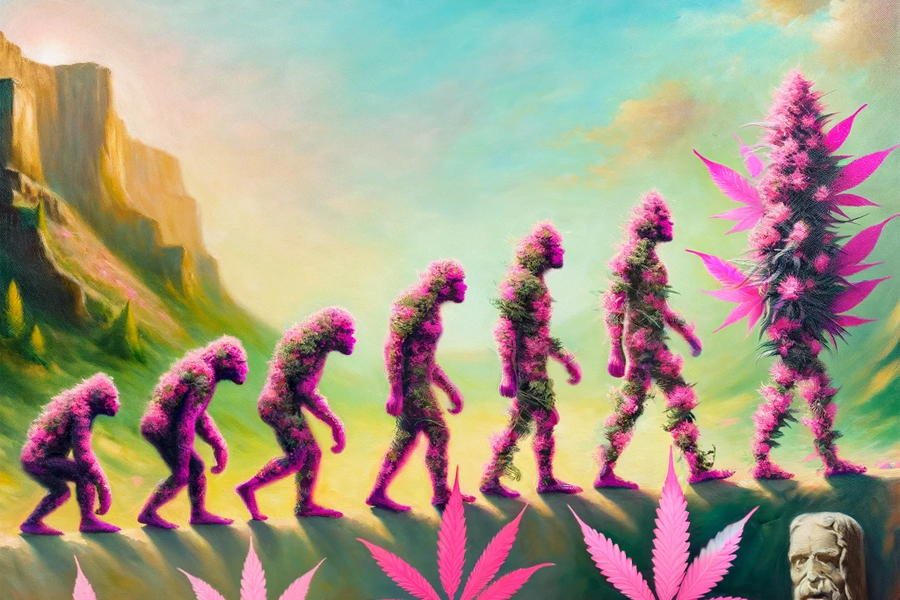Weed background from Ancient Origins to Widespread Prohibition
Cannabis, commonly known as marijuana, has been cultivated and used by humans for thousands of years. The earliest evidence of cannabis use dates back to ancient China and India, where it was utilized for spiritual, medicinal, and recreational purposes. Ancient texts describe cannabis as a “divine plant” capable of alleviating pain and inducing meditative states. Over time, the cultivation and use of cannabis spread from Asia to Africa, the Middle East and Europe. Cannabis preparations were commonly used to treat a variety of ailments, from inflammation and pain to gastrointestinal issues. The medicinal properties of cannabis became widely recognized during the 1800s, and extracts of cannabis leaf were even available at pharmacies.
The 20th century shows a significant shift in the perception of cannabis. Regulations restricting the possession, sale and use of cannabis began to appear in the early 1900s in the United States. These restrictions culminated in the Marihuana Tax Act of 1937, which essentially prohibited cannabis nationwide. Several other countries soon followed suit, banning the non-medical use of cannabis through the 1961 Single Convention on Narcotic Drugs. While the medicinal use of cannabis was still permitted, research and access to medical cannabis sharply declined during this time.
The cannabis leaf: Chemical Composition and Effects
Cannabis refers to preparations derived from the plant Cannabis sativa. The cannabis plant includes over 400 chemical compounds, with delta-9-tetrahydrocannabinol (THC) being the prominent psychoactive cannabinoid. THC produces the characteristic “high” associated with cannabis use by binding to cannabinoid receptors in the brain. In addition to THC, cannabis contains other cannabinoids such as CBD, CBN CBC, and leaf weed, which also interact with the endocannabinoid system in the body. Different cannabis strains have varying levels of THC, CBD and other cannabinoids, resulting in different effects.
Besides cannabinoids, cannabis also contains aromatic compounds called terpenes. Terpenes such as myrcene, pinene and limonene influence the aroma, flavour and effects of different cannabis strains. The combination of cannabinoids, terpenes and other plant compounds produces the unique effects and benefits associated with cannabis.
The Re-Emergence of Medical Cannabis
In recent decades, there has been renewed interest in the potential medical applications of cannabis. Several conditions for which cannabis shows therapeutic potential include:
Pain: Cannabis can help reduce acute and neuropathic pain. Cannabinoids like THC and CBD activate CB1 and CB2 receptors involved in pain modulation.
Nausea and Vomiting: Cannabinoids found in cannabis can suppress nausea and vomiting induced by chemotherapy or other conditions. THC-based medications like dronabinol and nabilone are FDA-approved for treating chemotherapy-related nausea.
Appetite Stimulation: Cannabis can stimulate appetite in conditions like HIV, cancer and dementia, where wasting and cachexia are a concern. THC acts on CB1 receptors involved in appetite regulation.
Epilepsy: Cannabidiol (CBD), a non-intoxicating cannabinoid, can reduce seizure frequency in treatment-resistant forms of epilepsy like Dravet and Lennox-Gastaut syndromes.
Anxiety and PTSD: Cannabis with higher CBD content appears effective at reducing symptoms of anxiety, stress and post-traumatic stress disorder (PTSD). CBD regulates neurotransmitters involved in mood and stress response.
Liquid cannabis tinctures provide an easy way to consume measured cannabinoid doses sublingually. Cannabis pills offer accurate, discrete microdosing for medical users anytime relief is needed. These innovative product forms expand consumer options beyond just smoking. Cannabis-derived pharmaceuticals like Sativex (THC + CBD oromucosal spray) and Epidiolex (CBD oral solution) are also approved for specific medical indications. As laws and regulations continue to evolve, broader patient access to medical cannabis treatments is expected.
Modern Applications and Forms of Cannabis
Cannabis consumption methods have progressed significantly from the dried flower consumed through smoking or ingestion. Some modern forms of cannabis include:
Oils: Cannabis oils, thc-a like CBD and THC oils, allow precise dosing through oral use or inhalation. Popular oil-based products include tinctures, capsules and vape cartridges.
Edibles: Food items infused with cannabis, like chocolates, gummies and beverages, provide longer-lasting effects due to slower absorption through the digestive tract. cbn cannabinoid Effects can take 30-90 minutes to manifest.
Topicals: Cannabis-infused topical products like ointments, lotions and balms are used for localized symptom relief. Cannabinoids are absorbed through the skin without inducing psychoactive effects.
Concentrates: Solvent extraction processes like hydrocarbon extraction produce concentrates with very high levels of cannabinoids. Popular concentrate forms include oils, waxes, shatters, and isolates like CBD isolate.
Transdermals: Transdermal patches containing THC and other cannabinoids allow for controlled delivery through the skin over an extended period.
The cannabis plant has also been subject to extensive cross-breeding and genetic modification. Hydroponics and indoor cultivation allow manipulating factors like light, humidity and nutrients to optimize growth. This resulted in hybrid strains with distinctive cannabinoid and terpene profiles catered to different effects.
Conclusion
Over the past century, cannabis has undergone a remarkable transition from an ancient plant remedy to an illicit substance and now back to a valued therapeutic botanical. Ongoing changes in cannabis regulation and increased research into its compounds have validated the diverse medical applications of cannabis. While recreational use also remains popular in legal jurisdictions, the focus has shifted to responsible adult use and harm reduction. The story of cannabis highlights how proper regulation and education can harness the benefits of even controversial botanicals. As legal barriers continue to decrease, cannabis appears poised to become again an integral part of medical systems around the globe.
FAQs
Q: What is CBC cannabinoid?
A: CBC is a non-intoxicating compound in cannabis that may enhance THC’s effects and has anti-inflammatory properties.
Q: How do you make cannabis tea?
A: Bring water to a boil, add ground cannabis, remove from heat and let steep before straining and enjoying your cannatea.
Q: What is the history of cannabis use?
A: Cannabis has been used for millennia for fibre, food, and medicine. Archeological evidence finds that the earliest cannabis use dates back around 12,000 years ago.
Q: What are the most common medical uses of cannabis today?
A: Some common uses include chronic pain, chemotherapy-related nausea, muscle spasms, epilepsy, depression, anxiety, acne, arthritis, PTSD, Alzheimer’s, Parkinson’s, and inflammation. Ongoing research explores its potential for other conditions as well






